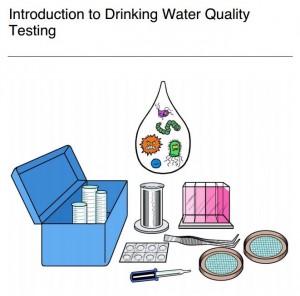Newly updated Drinking Water Quality Testing Manual. CAWST, 2014.
CAWST – Centre for Affordable Water and Sanitation Technology – has released a newly-updated Drinking Water Quality Testing manual that provides introductory information and resources on drinking water quality testing.
The manual is for WASH implementers interested in doing drinking water quality testing as part of the implementation, monitoring or evaluation of household water treatment and safe storage (HWTS) projects.
Among the updates, the manual has been broadened to include drinking water quality testing for small-scale community water systems (in addition to HWTS). The updates also address unique conditions in different regions, featuring customized country fact sheets. The manual now features an expanded water sampling section, including step-by-step instructions, illustrations and guidance on how to sample different HWT technologies.
Additional highlights from the manual:
- Guidance to help determine if drinking water quality testing is an appropriate tool for your project
- Characteristics of safe drinking water
- Planning for drinking water quality testing
- Sanitary surveys as a means to observe water quality
- New product sheets for various water quality testing products and equipment
- Testing options, including portable field kits and laboratories
- Physical, chemical and microbiological parameters and test procedures
- Updated to reflect the latest Guidelines for Drinking Water Quality issued by the WHO
When the Aquaya Institute was preparing a three-month water sampling and testing campaign for the Port Harcourt Water Corporation and the Ministry of Water in Port Harcourt, Nigeria, the organization incorporated CAWST’s newly-updated drinking water quality materials into the training. 
“The interactive activities were particularly effective and compelling – our participants commented on how much they liked activities more than presentations,” Aquaya Research Associate Emily Kumpel said. “Having access to these materials hugely decreased our prep time and let us focus on other things that we needed to handle directly, such as logistics, staffing and getting the testing program up and running.”
The manual outlines the advantages and limitations of both low-tech and high-tech testing methods, as well as the relationships between each method.
The new section on sanitary inspections – including sanitary inspection forms – expands the monitoring tools available to those working in areas where logistical and economic hurdles make it difficult to test drinking water quality as a means to protect public health.
Smaller community water supply and HWTS projects that are just starting often do not conduct water quality testing, although many project implementers have shown initial interest in drinking water quality testing. This is due to implementers often finding that testing can be a difficult and expensive task.
In some cases no testing is done or they may do random testing that is not part of a regular and structured monitoring program. Doing occasional or random tests may provide a false sense of security or inconclusive results as water quality can vary widely and rapidly.
This observation and the overall lack of testing available in developing countries highlighted the need for a manual that provides guidance for implementing rapid, simple and inexpensive test methods.
Implementers exploring how to use, adapt or customize these or other CAWST materials can contact CAWST for free consulting support at resources@cawst.org.



